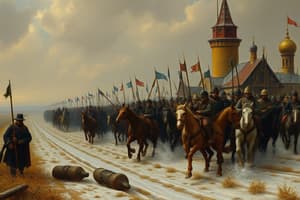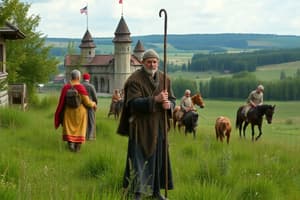Podcast
Questions and Answers
What role did Vladimir play in the Christianization of Kievan Rus'?
What role did Vladimir play in the Christianization of Kievan Rus'?
Vladimir unified Kievan Rus' under Orthodox Christianity to consolidate his rule and strengthen ties with Byzantium.
How did Yaroslav the Wise contribute to the cultural flourishing of Kievan Rus'?
How did Yaroslav the Wise contribute to the cultural flourishing of Kievan Rus'?
Yaroslav fostered education, created the legal code Russkaya Pravda, and cultivated alliances, promoting cultural and political stability.
What impact did the Christianization of Kievan Rus' have on its artistic traditions?
What impact did the Christianization of Kievan Rus' have on its artistic traditions?
The adoption of Christianity led to the development of icon painting and manuscript copying as important cultural practices.
What were the consequences of Yaroslav’s death for Kievan Rus'?
What were the consequences of Yaroslav’s death for Kievan Rus'?
Why is Kievan Rus' considered significant in the context of Eastern European history?
Why is Kievan Rus' considered significant in the context of Eastern European history?
What motivated the Slavic tribes to invite Rurik to govern them?
What motivated the Slavic tribes to invite Rurik to govern them?
How did Oleg contribute to the formation of Kievan Rus’?
How did Oleg contribute to the formation of Kievan Rus’?
What does the name 'Rus’' likely refer to, and what is its significance?
What does the name 'Rus’' likely refer to, and what is its significance?
What types of goods did Kievan Rus’ export and import during its trade with Byzantium?
What types of goods did Kievan Rus’ export and import during its trade with Byzantium?
What was the significance of Oleg nailing his shield to the gates of Constantinople?
What was the significance of Oleg nailing his shield to the gates of Constantinople?
Why did Vladimir the Great choose Byzantine Christianity over other religions?
Why did Vladimir the Great choose Byzantine Christianity over other religions?
What role did trade play in the development of Kievan Rus’?
What role did trade play in the development of Kievan Rus’?
How did the Varangians impact the social and political structure of the Slavic tribes?
How did the Varangians impact the social and political structure of the Slavic tribes?
Flashcards
Christianization of Kievan Rus'
Christianization of Kievan Rus'
The adoption of Christianity by Kievan Rus' in the 10th century, influenced by Byzantine Empire.
The Golden Age of Kievan Rus'
The Golden Age of Kievan Rus'
The flourishing period of Kievan Rus' under Yaroslav the Wise, marked by political stability, cultural development, and strong alliances with European powers.
Russkaya Pravda
Russkaya Pravda
A legal code created by Yaroslav the Wise during the Golden Age of Kievan Rus', reflecting the laws and social norms of the time.
Division of Kievan Rus' after Yaroslav's death
Division of Kievan Rus' after Yaroslav's death
The division of Kievan Rus' amongst Yaroslav the Wise's sons after his death, leading to internal conflicts and ultimately weakening the kingdom.
Signup and view all the flashcards
Saint Sophia Cathedral
Saint Sophia Cathedral
Saint Sophia Cathedral in Kyiv, a prominent example of Kievan Rus' architecture and a legacy of the Christianization era.
Signup and view all the flashcards
Varangians
Varangians
A group of Scandinavian Vikings who traveled to Eastern Europe to trade, conquer, and form alliances with the Slavic tribes.
Signup and view all the flashcards
Slavs
Slavs
The indigenous tribes living in the region that would later become Russia, Ukraine, and Belarus. They were farmers and traders, yet lacked a unified state.
Signup and view all the flashcards
Rurik
Rurik
Founder of the Rurik Dynasty, a Varangian chieftain invited to rule over the Slavic tribes, considered to be the start of Kievan Rus'.
Signup and view all the flashcards
Oleg of Novgorod
Oleg of Novgorod
The ruler who moved south from Novgorod to Kyiv, conquering the strategically important city and establishing it as the capital of Kievan Rus'.
Signup and view all the flashcards
Kyiv
Kyiv
The capital of Kievan Rus', located on the Dnieper River. Its strategic location facilitated trade between the Baltic Sea and the Byzantine Empire.
Signup and view all the flashcards
The Primary Chronicle
The Primary Chronicle
The medieval Slavic history that narrates the origins of Kievan Rus', including the story of Rurik's arrival and the founding of Kyiv.
Signup and view all the flashcards
Why did Vladimir choose Christianity?
Why did Vladimir choose Christianity?
The main reason Vladimir chose Byzantine Christianity for Kievan Rus'. It offered a way to unite the Slavic tribes under a single religion, providing spiritual and political unity.
Signup and view all the flashcards
Vladimir the Great
Vladimir the Great
The ruler who unified the Slavic tribes and converted Kievan Rus' to Christianity.
Signup and view all the flashcardsStudy Notes
Kievan Rus': Formation and Flourishing (9th-12th Century)
- Slavic tribes, initially independent, lacked a unified state.
- Varangians (Vikings), seeking trade and conquest, interacted with Slavs.
- Rurik, a Varangian chieftain, was invited to rule over Slavic tribes, founding the Rurik Dynasty.
- Oleg of Novgorod, Rurik's successor, established Kyiv as the capital of Kievan Rus'. Strategically located on the Dnieper River.
- "Rus'" likely derived from a Scandinavian term meaning "rowers" or "sailors."
- Kievan Rus' thrived as a trade center, exporting furs, honey, and slaves, and importing luxury goods like silk and wine.
- Relationships with Byzantium were important, evidenced by Oleg's actions.
- Vladimir the Great (r. 980–1015) united Slavic tribes by choosing Byzantine Christianity.
- Reasons for choosing Christianity: political alliances with Byzantium; consolidating power; appeal of Orthodox rituals.
- Christianization significantly impacted Kievan Rus' culture, art, and architecture (e.g., Saint Sophia Cathedral).
- Yaroslav the Wise (r. 1019–1054) presided over a golden age, creating a legal code (Russkaya Pravda), and fostering alliances with Europe, and promoting education.
- Cultural flourishing involved churches, monasteries as centers of learning, and growth in icon painting and manuscript copying.
- Division of Kievan Rus' among Yaroslav's sons after his death signaled the beginning of its decline.
- Importance of Kievan Rus': laid foundation for Russia, Ukraine, and Belarus; established Eastern Orthodoxy as a defining cultural aspect; and connected Eastern Europe to the wider medieval world.
Studying That Suits You
Use AI to generate personalized quizzes and flashcards to suit your learning preferences.




